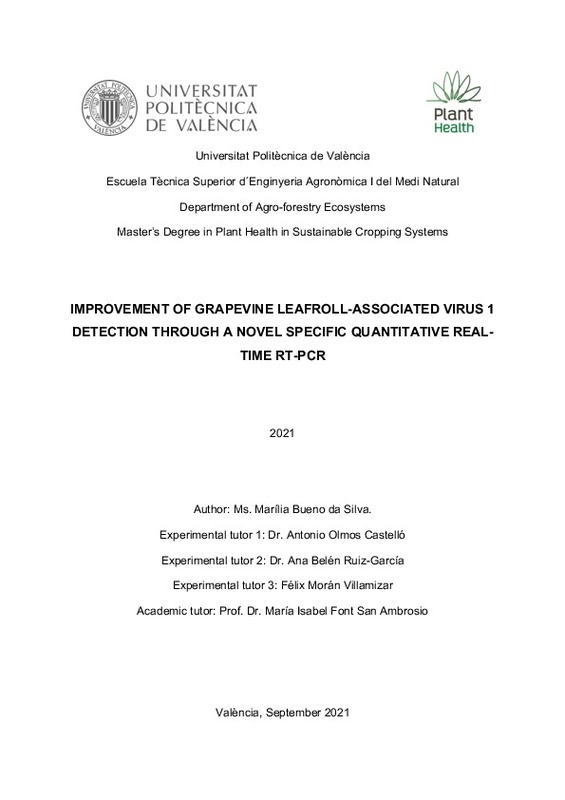JavaScript is disabled for your browser. Some features of this site may not work without it.
Buscar en RiuNet
Listar
Mi cuenta
Estadísticas
Ayuda RiuNet
Admin. UPV
Improvement of Grapevine Leafroll-Associated Virus 1 Detection through a Novel Specific Quantitative Real-Time RT-PCR
Mostrar el registro sencillo del ítem
Ficheros en el ítem
| dc.contributor.advisor | Font San Ambrosio, Maria Isabel
|
es_ES |
| dc.contributor.advisor | Olmos Castelló, Antonio
|
es_ES |
| dc.contributor.advisor | Moran Villamizar, Felix Eduardo
|
es_ES |
| dc.contributor.author | Bueno Da Silva, Marília
|
es_ES |
| dc.date.accessioned | 2021-10-15T07:50:35Z | |
| dc.date.available | 2021-10-15T07:50:35Z | |
| dc.date.created | 2021-09-17 | |
| dc.date.issued | 2021-10-15 | es_ES |
| dc.identifier.uri | http://hdl.handle.net/10251/174764 | |
| dc.description.abstract | [ES] En la actualidad, la vid (Vitis vinifera L.) es uno de los cultivos más importantes del mundo por su impacto económico y social. Como en muchos otros cultivos, las plantas de vid son susceptibles a varios tipos de enfermedades causadas por microorganismos patógenos. El virus del enrollado 1 (GLRaV-1) está asociado a la enfermedad del enrollado de la vid y se considera a nivel nacional y europeo como un patógeno que debe estar ausente en el material vegetal propagativo. Por ello, es importante utilizar técnicas de detección específicas, sensibles y fiables que permitan determinar el estado sanitario de las plantas. El objetivo de esta investigación se ha centrado en el desarrollo de un nuevo método basado en una RT-PCR cuantitativa en tiempo real dirigida a la región genómica de la prote.na de recubrimiento para mejorar la detección de GLRaV-1 en la vid, incluyendo un control interno del huésped en una reacción dúplex. Con este fin, se han recuperado tres nuevos genomas completos de GRLaV-1 mediante secuenciación masiva (High-throughput sequencing, HTS) y se han alineado con todas las secuencias disponibles en las bases de datos. Para la validación del método siguiendo los estándares de la EPPO, se han analizado 65 muestras naturalmente infectadas por GLRaV-1 de diferentes orígenes y variedades y se han comparado con otros dos métodos de detección descritos previamente basados en PCR. Los resultados muestran que el nuevo protocolo diseñado en este estudio es mucho más específico y sensible que los otros métodos. El método diseñado permite la cuantificación absoluta del título viral y es capaz de detectar tan solo 2 copias del virus. La nueva técnica se ha aplicado para el diagnóstico de 241 muestras de campo. | es_ES |
| dc.description.abstract | [EN] Nowadays, grapevine (Vitis vinifera L.) is one of the most important crops in the world due to its economic and social impact. As in many other crops, grapevine plants are susceptible to various types of diseases caused by pathogenic microorganisms. Grapevine leaf roll associated virus-1 (GLRaV-1) is a virus associated with grapevine leafroll disease and it is considered at national and European level as a pathogen that must be absent in propagative plant material. For this reason, it is important to use specific, sensitive, and reliable detection techniques that allow determining the sanitary status of the plants. The objective of this research has focused on the development of a new method based on a TaqMan quantitative real time RT-PCR targeted to coat protein genomic region to improve the detection of GLRaV-1 in grapevine, including a host internal control in a duplex reaction. To this end, three new GRLaV-1 full genomes have been recovered by HTS and aligned with all sequences available in the databases. For the validation of the method following EPPO standards, 65 naturally infected samples from different origins and cultivars were analyzed and compared with two other PCR-based detection methods previously reported. The results show that the new protocol designed in this study is much more specific and sensitive than the other methods. The method designed allows the absolute quantitation of the viral titter, it is able to detect as little as 2 viral target copies and has been applied for the diagnosis of 241 field samples. | es_ES |
| dc.format.extent | 39 | es_ES |
| dc.language | Inglés | es_ES |
| dc.publisher | Universitat Politècnica de València | es_ES |
| dc.rights | Reconocimiento - No comercial - Sin obra derivada (by-nc-nd) | es_ES |
| dc.subject | Virus de RNA de plantas | es_ES |
| dc.subject | Secuenciación de alto rendimiento (HTS) | es_ES |
| dc.subject | Métodos de detección basados en PCR | es_ES |
| dc.subject | Grapevine viruses | es_ES |
| dc.subject | RT-PCR en tiempo real | es_ES |
| dc.subject | Detección | es_ES |
| dc.subject | GLRaV-1 | es_ES |
| dc.subject | Real-time RT-PCR | es_ES |
| dc.subject | Detection methods | es_ES |
| dc.subject | PCR-based detection methods | es_ES |
| dc.subject | High-throughput sequencing (HTS) | es_ES |
| dc.subject.classification | MICROBIOLOGIA | es_ES |
| dc.subject.classification | PRODUCCION VEGETAL | es_ES |
| dc.subject.other | Máster Universitario Erasmus Mundus en Sanidad Vegetal en Agricultura Sostenible/ European Master degree in Plant Health in Sustainable Cropping Systems-Màster Universitari Erasmus Mundus en Sanitat Vegetal en Agricultura Sostenible / European Master's Degree in Plant Health in Sustainable Cropping Systems | es_ES |
| dc.title | Improvement of Grapevine Leafroll-Associated Virus 1 Detection through a Novel Specific Quantitative Real-Time RT-PCR | es_ES |
| dc.type | Tesis de máster | es_ES |
| dc.rights.accessRights | Abierto | es_ES |
| dc.contributor.affiliation | Universitat Politècnica de València. Departamento de Ecosistemas Agroforestales - Departament d'Ecosistemes Agroforestals | es_ES |
| dc.description.bibliographicCitation | Bueno Da Silva, M. (2021). Improvement of Grapevine Leafroll-Associated Virus 1 Detection through a Novel Specific Quantitative Real-Time RT-PCR. Universitat Politècnica de València. http://hdl.handle.net/10251/174764 | es_ES |
| dc.description.accrualMethod | TFGM | es_ES |
| dc.relation.pasarela | TFGM\146289 | es_ES |






